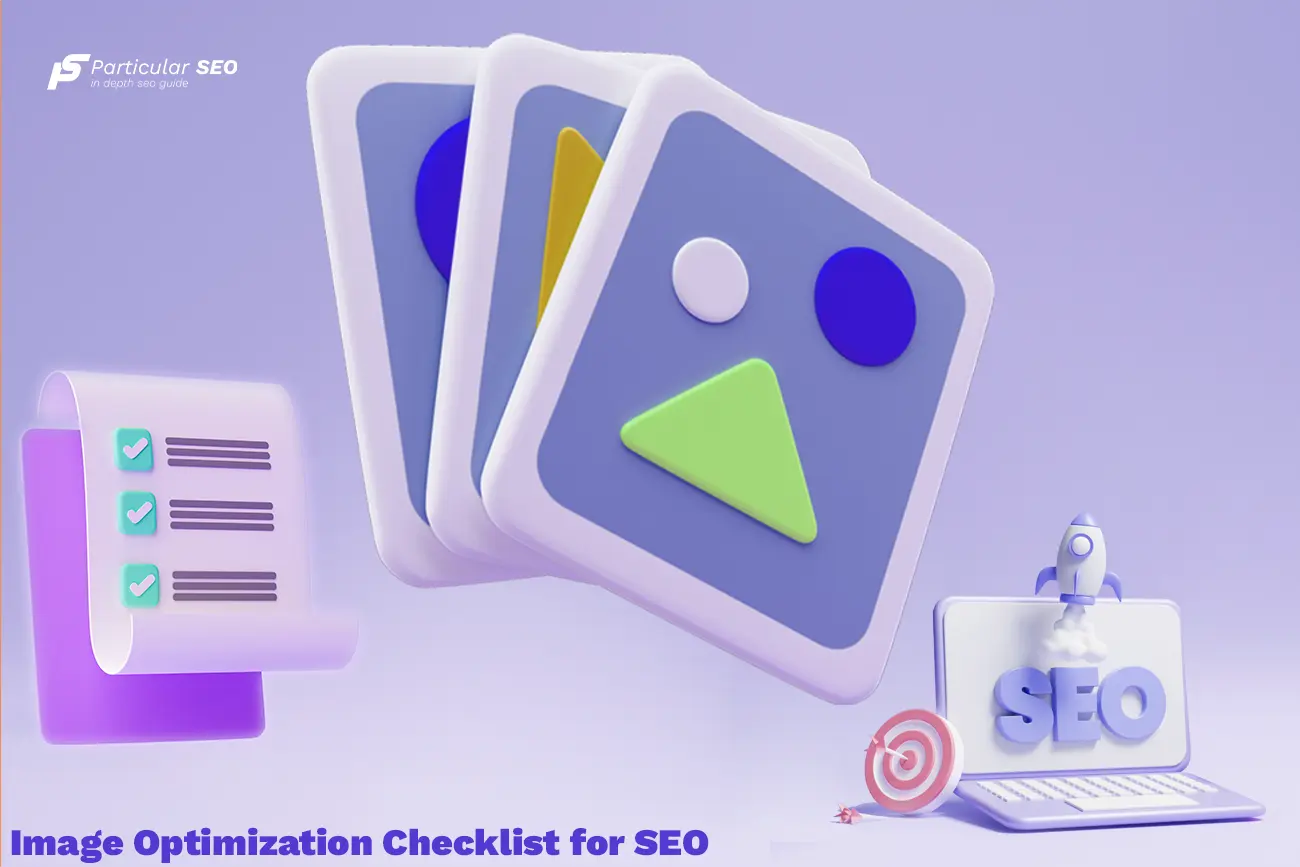
The Ultimate SEO Image Optimization Checklist: Elevate Your Technical SEO
Website Images Compression for SEO
Imagine image compression as a magic spell for faster web pages. It shrinks image file sizes without sacrificing quality, enhancing load times and SEO.
When images are heavy, your website slows down. This is a turn-off for both users and search engines. By compressing images, you strike a balance between great visuals and speedy performance. Use online tools or image editors to optimize images for the web.
Image Format Selection for SEO
Choosing the right image format is like picking the perfect brush for your SEO canvas.
JPEG
Ideal for photographs and images with many colors. This type is non-transparency.
PNG
Great for images with transparency or crisp graphics. Like paperclips, logos or other similar objects
WebP
PS: the all-in-one image format is a true chameleon.
It seamlessly handles transparency and non-transparency becoming the go-to choice for diverse media like PNGs, JPEGs, GIFs, and videos.
This image format supports both transparency and non-transparency, making it suitable for various types of media such as PNGs, JPEGs, GIFs, and videos.
AVIF
Other revolutionary type of images like WebP It’s designed to outshine JPEG, offering superior compression and image quality.
It brings advanced perks like transparency and animation support.
AVIF’s winning hearts among devs, embraced by major browsers and OS for lightning-fast performance and smaller files.
But yet it is not supported by all web browsers for now.
Image Alt Text for SEO
Alt text is the unsung hero of web accessibility and SEO. It’s like a helpful tour guide for search engines and users with visual impairments.
example :
<img src= “https://imageurlexample.com/logo.png” alt=” logo of imageurlexample “ >
what it should be :
Creativie : Alt text describes images with creativity and relevance.
have purpose : It provides context, especially when images fail to load.
SEO Boost: Well-crafted alt text enhances your website’s search engine ranking.
Contain a keyword : Include keywords but keep it natural.
For example, if it’s an image of a red apple, your alt text could be: “Juicy red apple ready to be picked.”
Image File Names for SEO
Image file names are your image’s identity card in the digital world.
Descriptive Names : Use names that describe the image, like “red-apple.jpg.”
SEO Benefit : Keywords in file names can boost your SEO.
Organized Content : Keep your images organized in relevant folders.
Think of your image file name as the title of a painting in a gallery – it should reflect what’s inside!
Responsive Images for SEO
Responsive images are the essential for web design, ensuring your site looks fantastic on all devices.Adapt to Screen Size these images change size and resolution depending on the user’s device like desktop, tablet, or smartphone.
example :
<img srcset=”myimage.jpg 480w, myimage-800w.jpg 800w” sizes=”(max-width: 700px) 780px, 400px” src=”myimage-800w.jpg” alt=”Elva dressed as a fairy” />
Why Responsive Images Matter :
Improved User Experience
Users get crisp, perfectly sized images, not pixelated or oversized ones.
Faster Load Times
Smaller images for smaller screens mean quicker load times, which Google loves.
Lazy Loading for SEO
Lazy loading is like a VIP pass for web page speed, and Google loves speedy sites.
What image Lazy Loading does
Defer Off-Screen Images: Lazy loading delays the loading of images until users scroll down, so only visible images load initially.
Why image Lazy Loading Matters:
Faster Initial Load
Pages appear faster, as they aren’t weighed down by loading all images at once.
Improved SEO
Faster pages often lead to better SEO rankings. Google rewards quick-loading websites.
for more clarifacation
responsive images adapt to different screens for a great user experience
while lazy loading prioritizes speed and SEO rankings by deferring off-screen image loading. A winning combo for modern web design!
Image Sitemaps for SEO:
Guiding Search Engines to Your Visual Content
Image sitemaps are like the map to buried treasure for search engines.
These specialized sitemaps lead search engines to the wealth of visual content on your website.
Image sitemaps include details like image URLs captions and licensing information.
By using image sitemaps you make it easier for search engines to understand your images which can lead to better image indexing and visibility in search results.
So, remember, if you want search engines to admire your images, give them a roadmap to follow!
Image Dimensions for SEO
Displaying Image hieght and width in html
example :
<img src= “https://imageurl.com/logo.png” alt=”” width=”1200″ height=”900″>
Image dimensions are the canvas size for your web artworks.
When it comes to SEO you must consider responsive design It’s like having an artist’s masterpiece fit perfectly on any screen.
By specifying image dimensions in your HTML you prevent those annoying layout shifts when images load.
This not only creates a smoother user experience but also impresses search engines as they appreciate a well-structured page.
So in the art gallery of SEO, remember that image dimensions matter!
Using Content Delivery Networks (CDNs) for SEO: A Simple Guide
CDNs are your SEO secret weapon, even if you’re just starting out. Here’s how they work their magic in plain English:
Supercharge Loading Speed : CDNs spread your web content across multiple servers worldwide. When a user requests your content, it’s delivered from the server nearest to them. This minimizes loading time and enhances the user experience.
SEO-Friendly Fast Loading : Google loves fast-loading websites. CDNs significantly reduce page load times, a crucial ranking factor. This means your site has a better shot at reaching the top of search results.
Global Reach : With CDNs, your website can handle traffic spikes without breaking a sweat. Whether you’re a local business or a global player, CDNs ensure your site stays accessible and speedy.
In a nutshell, CDNs are like your site’s delivery heroes, making it faster, more accessible, and SEO-friendly. So, whether you’re a beginner or a seasoned pro, make friends with CDNs for an SEO boost!
#CDN #ImageOptimizationTips
Image optimization for SEO best practices
Image Descriptions
Provide descriptive captions or descriptions alongside images especially if they are part of a gallery or infographic.
Image Metadata
including title and copyright information to enhance image relevance.
Structured Data for Images
Implement structured data (schema markup) for images to provide search engines with additional information about the image, such as subject matter, author, or licensing details.
Avoid Image Text
Minimize the use of text within images as search engines may not easily index text in images. Instead, use HTML text where possible.
Image Quality
Balance image quality with file size to ensure that images look good while loading quickly.
Image SEO Plugins
If using a content management system like WordPress, consider using image SEO plugins to simplify and automate some of these optimization tasks.
Image Compression Tools
Utilize image compression tools before uploading it , including online services or image editing software, to achieve the best balance between quality and file size.
These additional considerations can further enhance image optimization for SEO, but the core 10 tasks remain fundamental to the process.
things to avoid in image optimization for SEO
Image Over-Optimization
Avoid excessive compression that significantly reduces image quality, making them appear pixelated or distorted.
Keyword Stuffing
don`t stuff image file names, alt text, or descriptions with keywords. Use descriptive and relevant content .
Ignoring Accessibility
if your website use div`s as hell ( old or non HTML5 websites do ) use ARIA for images which is essential for web accessibility and SEO .
Using Non-SEO-Friendly Image Formats
Avoid using image formats that are not optimized for the web, such as BMP or TIFF
PS : do not use GIF in your website .
Unnecessarily Large Images
Don’t use images with excessive dimensions or file sizes for the intended use.
Remember, optimizing images for SEO is about finding the right balance between quality, performance, and accessibility while following best practices.


You have mentioned very interesting points! ps nice